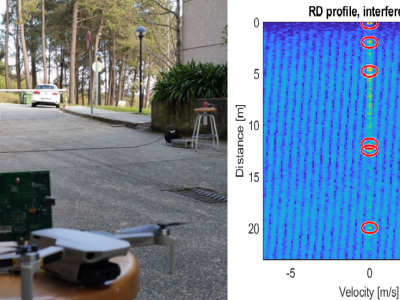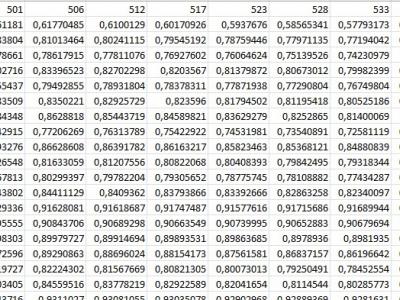Signal Processing
This repository stores the supplementary material associated to the work "Empirical Validation of a Class of Ray-Based Fading Models". That work is related with stocastich channel characterization and empirical validation. Three alternative scenarios are studied: anechoic and reverberation chambers, and indoor environments. Through the generation of linear combinations of different path measurements, a large amount of possible configurations appear for each one. In order to support the content of this work, several animations have been carried out.
- Categories:
 209 Views
209 ViewsWe discuss the use of multi-rate FIR filters in radio frequency (RF) transient spectroscopy as well as the implementation challenges these multi-rate filters face when used in this application to reduce the sampling rate (decimation) and raise the sampling rate (interpolation). On a Texas Instruments TMS320-C30 DSP processor, all implementation measurements given here were carried out.
- Categories:
 121 Views
121 ViewsWe present a sEMG signal database corresponding to the Indian population named “ElectroMyography Analysis of Human Activities - DataBase -2 (EMAHA-DB2).” This data set consists of two different weight training activities which involve isotonic and isometric contractions. Weight training activities are effective for improving muscle strength, overall health, and regaining limb functionality for people undergoing rehabilitation post stroke-related episodes. The EMG signals acquired during weight training can be used for muscle recruitment analysis.
- Categories:
 914 Views
914 Views
The file ExplanationForPaper.m contains the code that draws the figures in "Periodograms and The Method of Averaged Periodograms." It also produces many, many other, related figures and performs many related calculations. By reading through the code and running it, the reader will be able to "experience" the mateiral presented in the article. The reader will also see material related to the additional application discussed at the end of "The method of averaged periodograms" and just before the section "Numerical examples."
- Categories:
 189 Views
189 Views
This dataset corresponds to the paper Calibration of a Hail-Impact Energy Electroacoustic Sensor, submitted to IEEE Transactions in Instrumentation and Measurement by Florencia Blasina, Andrés Echarri, and Nicolás Pérez.
The dataset corresponds to the voltage signals acquired regarding several steel-ball impacts on the proposed hail-sensor plate to calibrate it.
- Categories:
 89 Views
89 Views
Experimental measurement data was obtained utilizing RCbenchmark 1780 with full-range PWM signals. Measurements were made for two series of setups.
First series is related to low-voltage setups using the following T-MOTOR components: - motors: MN4014 400Kv, MN5212 340Kv, MN501-S 360Kv, U7 280Kv, MN6007 320Kv, P60 340Kv, MN701-S 280Kv; - ESC: Air 40A, Flame 40A, Flame 70A, Alpha 60A, Flame 100A; - propellers: P17×5.8, P18×6.1, P20×6, P22×6.6, P24×7.2, G26×8.5; - battery: 6-cell (6S) Lithium polymer (LiPo).
- Categories:
 166 Views
166 ViewsIn the attached dataset, a continuous record of 2493 chirp-sequence FMCW radar burst is presented. The data consist of the direct ADC output of an AWR1443BOOST radar board from Texas Instruments during 47.37 s of continuous operation. During this time, two FMCW radars of the model AWR1642BOOST were continuously transmitting sweeps with its main lobe aimed towards the first radar. This produces the apparition of two different uncorrelated interferences at the victim radar side, which can be seen on different indexes of the provided capture.
- Categories:
 1930 Views
1930 ViewsEl carbono orgánico (OC) y el nitrógeno total (N) son
Nutrientes sensibles para el crecimiento de las plantas. La presencia de estos nutrientesEl carbono orgánico (OC) y el nitrógeno total (N) sonOrganic carbon (OC) and total nitrogen (N) are es-Organic carbon (OC) and total nitrogen (N) are sential nutrients for plant growth. The presence of these nutrierganic carbon (OC) and total nitrogen (N) are ews-
w
sential nutrients for plant growth. The presence of these nutrients
in acceptable quantities can generate an optimal environment for
- Categories:
 39 Views
39 Views
The dataset is collected from the xeno-canto website, which is a public website to share bird sounds from around the world . We first collect 15,300 bird sounds from one second to fifteen seconds. Unlike many audio denoising datasets which have manually added artificial noise, our collected bird sounds contain natural noises, including wind, waterfall, rain, etc.
- Categories:
 830 Views
830 ViewsThis paper investigated how to increase the number of connections among users in hierarchical non-terrestrial networks (HNTNs) assisted disaster relief service (DRS). We aim to maximize the number of satisfactory connections (NSCs) by optimizing the unmanned aerial vehicles (UAV) radio resources, computing resources, and trajectory at each time slot. In particular, the UAVs are exploited as aerial base stations (ABSs) to provide a link for the reduced capability (RedCap) user equipment (UE) based on power domain non-orthogonal multiple access (PD-NOMA).
- Categories:
 609 Views
609 Views


